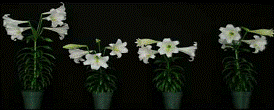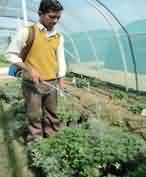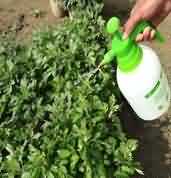फूलों की खेती में प्लांट ग्रोथ रेगुलेटर की भूमिका
The use of PGR's in modern horticulture is well established, more particularly horticulture in industrially advanced countries and their application is fast picking up in the developing nations as well.
In fact PGRs have become integral component of agro-technical procedures of cultivated ornamental crops, since the regulations for usage of chemicals in ornamental crops are less stringent unlike those in food crops.
Thus their application in these crops has been extended to alter a variety of responses. Some plant species or cultivars are responsive to specific PGRs, but not all PGRs.
Hormone can be defined as a substance produced in one part of the organism and transferred to another part of the same organism where it affects a specific physiological function. The hormones are required only in minute quantities to produce large specific physiological process.
The term growth regulator is applied to organic compounds, other than nutrients, which when used in minute quantities can either inhibit, stimulate, or alter growth.
These broadly grouped in to two, growth promoters which stimulates or alters the growth favourably and growth retardants are those which inhibit or alter the growth negatively. Ornamental crops find extensive use of growth regulators for modifying their developmental processes.
Within the broad group of plant hormones some act as growth promoters, others act as growth retardants.
The major areas where growth regulators are used in floriculture are:
- Plant propagation
- Plant height control
- Breaking or prolonging dormancy
- Promotion of vegetative growth
- Regulation of flowering
- Improvement of spike and flower quality
- Weed control
- Increasing the yield of flowers, bulbs, corms and cormels
- Extending the vase life of flowers
- Inhibition of senescence and promotion of corm and cormel development
Plant growth regulators in very minute quantities can induce above mentioned responses dramatically. The response to PGR’s however varies with the cultivar, age of the plant, light, temperature, availability of mineral nutrients, vigour of the plant and its endogenous hormonal content.
1. Plant Propagation
There are three methods of propagation employed in flower crops viz., asexual or vegetative methods; sexual (through seed) and micro-propagation (through tissue culture). Majority of ornamental plants are propagated by vegetative methods such as stem and leaf cuttings, by bulbs, corms and tubers.
A). Vegetative Propagation: Rose, carnation, chrysanthemum, gerbera. Auxins (IBA, NAA, IAA) are extensively used for rooting of the cuttings. The most commonly and widely used auxin in promoting rooting is IBA (Indole Butyric acid) followed by NAA and IAA.
The mixtures of two or more auxins are more effective (synergistic effect). There are 3 methods of auxins application for inducing rooting
- Prolonged soak treatment for 24 hours at low concentrations (25-100 ppm)
- Quick dip method-dipping the basal portion of the cuttings in higher concentrations of 1000-10000 ppm for 5 seconds to 2 minutes depending upon the nature of the cuttings, whether they are soft or hard wood.
- Dipping the wet basal portion of the cuttings in tale mixed with auxin (500-12000 ppm)
The success of rooting depends on some external and internal factors like Rainy season is the best, Photoperiod, Light, Temperature, Aeration, Humidity, nutrient status of the cutting and endogenous auxins level in the cutting for eg.
For bougainvillea, hard wood cuttings are used for their propagation, 1000-3000 ppm, IBA in quick dip method is the best. NAA at 1000 ppm increases the percentage of rooting and reduces the time taken for rotting.
B). Seed propagation: All seasonal flowers, marigold, antirrhinum, pansy, petunia, phlox. Verbena, sweet alyssum, candytuft, sweet sultan, coreopsis, gaillardia, larkspur, lupin, etc
Seed treatment with lower doses of gibberellic acid improves germination percentage, seedling vigour, final population stand, etc in many seed propagated seasonal flowers.
C). Micro-propagation: Orchids, Anthurium, Carnation, and Gerbera. Cytokinins and auxins are widely used as supplements for induction of shoots and roots, respectively in the tissue cultured plantlets.
2. Plant growth promotion
Stem length is an important quality criteria in many commercial flower crops. Foliar spray of GA3 (100-400 ppm) can be employed to achieve this in crops like rose, chrysanthemum, carnation, dahlia, etc.
3. Apical dominance/ Enhancing Lateral Branching
To overcome the apical dominance, the routine is pinch or stop the main shoot which enables production of lateral shoots, e.g. Carnation, chrysanthemum. Use of PGR’s like MH (600 or 1000 ppm), ethephone (Florel), benzyladenine etc. promotes branching (lateral shoots) equal to that obtained through pinching. TIBA 25 ppm produces more branches than pinching in marigold.
4. Regulation of flowering
Growth regulators can be used for advancing or delaying the flowering and also to induce uniform flowering in several flower crops. Seed set can also be improved with foliar sprays of growth regulators. Thus PGR’s can be used to enhance, hasten or delay the flowering time in several flower crops.
GA3 – 5-25 ppm causes early flowering in antirrhinum. GA3 – 10 ppm applied 140 days after planting increases the number and size of flowers. GA3 – 100 or 200 ppm in dahlia induced early flowering.
In general, auxins (NAA or IAA) at higher doses (>100 ppm) delay flowering. GA3-100 & 150 ppm or 2, 4-D (1 ppm) and or IAA (150 ppm) at early bud stage increases the flower size and weight.
5. Seed Set and Yield
GA3 at lower concentration (5-10 ppm) improves fruit set and seed yield in many of the seasonal flowers viz., pansy, petunia, phlox, and cineraria. Seed treatment (by soaking) with IBA 5 ppm or GA3 5-10 ppm for 12-24 hours increased seed yield significantly than the control plants in Impatiens balsamina. This also improves the germination percentage.
Kinetins (BA 100 ppm) or GA3 (100 or 200 ppm) once or twice as foliar sprays improves the corm and bulb yield in gladiolus, tuberose etc.
6. Dormancy breaking
The chemicals like ethylene chlorohydrins or Ethera, Ethephon, Thiourea, Hydrogen cyanamide (Dor-break or Dormex) are used for breaking the dormancy of gladiolus corms and cormels. Soaking in 1000 ppm ethereal for 24 hours breaks the dormancy in gladiolus.
Prevention of sprouting is also essential in certain cases like transporting the bulbous material or storage of the material in order to reduce the mortality following the sprouting. PGR’s like Propyl gallate, MH, SADH, etc can be used for extending the dormancy period.
7. Extension of cut flower life
The vase life of cut flowers can be prolonged significantly by adding kinetins, Ethylene inhibitors (MCP1), HQ compounds in the vase water.
8. Weed control
Auxins like 2, 4 – Dichloro phenoxy acetic acid is an effective herbicide against broad leaved weeds (dicots), others include 2, 4, 5-tricholoro phenoxy acetic acid, MCPA (Methyl chlorophenoxya cetic acid).
9. Plant height control
Growth retardants like Maleic hydrazide, SADH, CCC, B-nine are used for height control of ornamental plants especially those grown in pots, terraces. Most of the retardants are specific in their action. A particular retardant may dwarf only a particular plant species while it may not be effective for others. An ideal growth retardant should be one which will be universally effective, non-phytotoxic and will prolong the postharvest life without leaving any harmful residual effect. Many growth retardants are available commercially for greenhouse flower production.
Table1. Common plant growth retardant active ingredients, trade names and manufacturers
| Active Ingredient | Trade Name | Manufacturer |
| Ancymidol | A-Rest®Abide® | SePRO Corp.Fine Americas, Inc. |
| Chlormequat chloride | Chlormequat E-Pro®Citadel®Cycocel® | Etigra, LLC,Fine Americas, Inc.OHP, Inc. |
| Daminozide | B-Nine®Dazide® | OHP, Inc.Fine Americas, Inc. |
| Ethephon | Florel® | Monterey Lawn and Garden Products, Inc. |
| Paclobutrazol | Bonzi®Downsize®Paczol®Piccolo® | Syngenta Crop ProtectionGreenleaf Chemical, LLCOHP, Inc.Fine Americas, Inc. |
| Uniconazole | Concise®Sumagic® | Fine Americas, Inc.Valent USA Corp. |
Table 2: Some commercially available PGRs for greenhouse flower production.
| Purpose | Product | Application method & rate | Precautions & remarks |
| Bedding Plants | |||
| To control plant height | A-Rest | 6 to 66 ppm spray. Use 15 ppm spray as a base rate and adjust as needed. | Plug culture and flat culture differ in recommended rates. The rates shown in this table include both plug (lower rates) and flat culture (higher rates) recommendations. Growers should refer to Horticulture Information on height control of greenhouse crops, for application techniques and timing for growth regulators on floricultural crops. For further information can Contact floricultural specialists at nearby KVK. |
| 0.06 to 0.12 mg a.i. drench for a 4 inch pot | Drench volumes and mg a.i. vary with pot size. | ||
| B-Nine +Cycocel | 800 to 5,000 ppm B-Nine + 1,000 to 1,500 ppm Cycocel applied as a tank mix spray | It is recommended to use the highest rate of Cycocel that does not cause excessive leaf yellowing, and then adjust the B-Nine rate up and down within the labeled range to attain desired level of height control. | |
| Bonzi | 30 ppm spray | Users should conduct trials on a small number of plants, adjusting the rates as needed for desired final plant height and duration of height control. Not recommended for use on fibrous begonia or vinca. | |
| 0.118 mg a.i. drench for a 6 inch pot | Drench applications are recommended only for bedding plants in 6 inch or larger containers. Not recommendedfor use on fibrous begonia or vinca. | ||
| Cycocel | 800 to 3,000 ppm spray | Users should conduct trials on a small number of plants, adjusting the rates as needed for desired final plant height and duration of height control. | |
| Sumagic | 1 to 50 ppm spray | Users should conduct trials on a small number of plants, adjusting the rates as needed for desired final plant height and duration of height control. | |
| To control plant height | A-Rest | 3 to 35 ppm spray | Plug culture and flat culture differ in recommended rates. The rates shown in this table include both plug (lower rates) and flat culture (higher rates) recommendations. Growers should refer to Horticulture Information. |
| Drench plug flats with a 0.5 to 1 ppm solution | For uniform application, use a subirrigation delivery system. Plug trays should not be excessively dry prior to the subirrigation treatment. | ||
| B-Nine | 1,500 to 2,500 ppm spray | Users should conduct trials on a small number of plants, adjusting the rate as needed for desired final plant height and duration of height control. Can be used at the beginning of the first true leaf stage through the finishing stage. | |
| B-Nine +Cycocel | 800 to 5,000 ppm B-Nine + 1,000 to 1,500 ppm Cycocel applied as a tank mix spray | It is recommended to use the highest rate of Cycocel that does not cause excessive leaf yellowing, and then adjust the B-Nine rate up and down within the labeled range to attain desired level of height control. | |
| Bonzi | 5 ppm spray | Users should conduct trials on a small number of plants, adjusting the rate as needed for desired final plant height and duration of height control. Plants should develop 1 to 2 true leaves prior to first application. | |
| Cycocel | 400 to 1,500 ppm spray | Users should conduct trials on a small number of plants, adjusting the rates as needed for desired final plant height and duration of height control. | |
| Sumagic | 0.5 to 10 ppm spray | Users should conduct trials on a small number of plants, adjusting the rate as needed for desired final plant height and duration of height control. Plugs can be especially sensitive to Sumagic. | |
| Bulb Crops | |||
| To control plant height | A-Rest | 25 to 50 ppm spray | Drench applications are more effective than sprays. For further information can Contact floricultural specialists at nearby KVK. |
| 0.25 mg a.i. drench for a 6 inch pot | Users should conduct trials on a small number of plants, adjusting the rate as needed for desired final plant height and length of height control. | ||
| Bonzi | 100 ppm spray | Apply uniformly to cover stems because it is not absorbed by leaves. | |
| 1.183 mg a.i. drench for a 6 inch pot | As a drench very active in soil. Drench volumes and mg a.i. vary with pot size. | ||
| 20 ppm bulb soak | Soak for 15 minutes. To make it more effective conduct trial on a small number of bulb crops for rate and soaking period (up to 1 hour) as desired the for final plant height. | ||
| Sumagic | 2.5 to 20 ppm spray | Late applications can reduce flowering, to adjust the rate and time of application conduct trials on a small number of plants, for desired final plant height | |
| 1 to 3 ppm drench | 8 to 10 times more active than Bonzi. Drench volumes and mg a.i. vary with pot size and very active as a drench application. | ||
| 1 to 10 ppm bulb soak | Soak for 1 to 5 minutes. To make it more effective conduct trial on a small number of bulb crops for rate and soaking period as desired the for final plant height. | ||
| Chrysanthemum, Cut | |||
| To reduce "neck" stretching | B-Nine | 2,500 ppm spray | Spray upper foliage 5 weeks after start of short-day treatment. It has low level activity and short residual effects. |
|
Chrysanthemum, Potted |
|||
| To control plant height | A-Rest | 25 to 50 ppm spray | Broad spectrum, Very active on bedding plants. Safe to use butRelatively expensive. |
| 0.25 to 0.50 mg a.i. drench for a 6 inch pot | Drench volumes and amount of product (mg a.i.) vary with pot size. | ||
| 1,250 to 5,000 ppm spray | Spray the product when new growth after pinching reaches to 1 to 2 inches long. Some varieties may require repeated application after 3 weeks. | ||
| 0.118 to 0.473 mg a.i. drench for a 6 inch pot | Drench volumes and amount of product (mg a.i.) vary with pot size. | ||
| Chrysanthemum, Garden | |||
| To increase lateralbranching | Florel | 500 ppm spray | Use of Florel delay in flowering with some growth inhibition effect. For the timing of applications read the product label. |
| Coleus | |||
| To control plant height | B-Nine | 2,500 to 5,000 ppm spray | Recommended rates vary for the Plug and flat culture. Always use lower rates plug and higher rates for flat culture. Growers should refer to Horticulture Information. |
| Cornflower(Centaurea) | |||
| To control plant height | A-Rest | 7 to 26 ppm spray | Recommended rates vary for the Plug and flat culture. Always use lower rates plug and higher rates for flat culture. |
| B-Nine | 2,500 to 5,000 ppm spray | ||
Note: ppm = parts per million, 1 ppm= 1mg or 1ml in one liter water,
PGR application tips:
First decide what product is best suited for the crop and the growth response that is desired. For example, if producing a crop more number of leaves, then a product like B-Nine is a good choice because of its excellent leaf absorption, for dips triazole-based product like paclobutrazol or uniconazole is a better choice.
Read the product labels carefully because it provides information on plant used, application method, volume, concentration and when to apply for a particular crop and trait. It also provides general precautions to take during its application.
Drenches should be applied to a moist growing condition. Drench rates are lower than spray rates, sometimes by a factor of 10 for paclobutrazol-type products. Drench applications tend to be very uniform as compare to spray applications. To avoid any mistake with PGRs, calculate and measure it twice.
PGR rates vary with the micro climate (specific growing conditions) on crops. To get better results first start with the testing of the product in your condition. PGR manufacturers, university researchers and other growers can provide advice on rates, but the actual applications have to be fine-tuned under each operation’s growing conditions.
Product labels typically do not cover rate recommendations for all ornamental plants. Further information you can get from PGR manufacturers/distributor’s technical resources in print and online that include information on research results and recommendations.
Disclaimer: Mention of product names and brand does not constitute an endorsement by Directorate of Floricultural Research, New Delhi – 110 012. All the data is collected from the literature available online to make the farmers/entrepreneurs aware of PGRs use in greenhouse flower production.
Effect of Bonzi on different Plants
1. Poinsettia

0 10 30 ppm
2. Dianthus

0 4 8 12 16 ppm
3. Petunia

0 4 8 12 ppm
4. Pansy

0 2.5 5 7.5 10 15 ppm
5. Larkspur

0 30 60 1 ppm
(spray) (drench)
6. Lily

0 120 60 30 ppm
Manual Spray Methods


Authors:
Puja Rai, Sellam Perinban, Jayoti Majumder and Babita Singh
Directorate of Floricultural Research, IARI, Pusa Campus, New Delhi-110012
Email:
